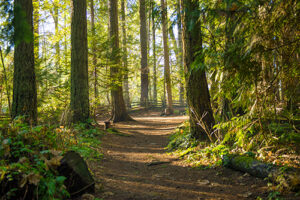
At Katahdin Cedar Log Homes, we often talk about the Northern White Cedar log as a truly sustainable building option. But let’s take a deeper dive into why cedar is an ideal log for log homes and how we enhance nature’s genius to help you enjoy your home for generations.
Sustainability Starts in the Forest
Each year we contract with trusted logging companies to harvest cedar logs from the vast forests of Maine. Northern White Cedar is abundant in the Northeastern United States. The US Forest Service Inventory and Analysis publishes data indicating there are more than 1 billion growing stock cedar trees in the Northeastern states of New York, New Hampshire, Vermont and Maine. Of those cedar tree stocks, 83 percent of these are located in Maine. That’s a lot of cedar!
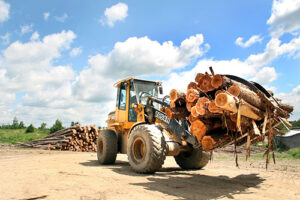 Not only is there abundance, but the majority (80 percent) of these Northern White Cedar trees in Maine grow on one million acres in lowlands and flatlands that are easily accessible. The trees prefer wetter soils, so they are often found growing in bogs or wetlands. The cedar harvesting season is often a short one, cold enough for the ground to firm up or freeze, but before heavy snows make passage difficult.
Not only is there abundance, but the majority (80 percent) of these Northern White Cedar trees in Maine grow on one million acres in lowlands and flatlands that are easily accessible. The trees prefer wetter soils, so they are often found growing in bogs or wetlands. The cedar harvesting season is often a short one, cold enough for the ground to firm up or freeze, but before heavy snows make passage difficult.
The cedar also grows in forest stands that are made up of a mixture of hard and soft wood trees— some valuable crops, other less so. As a result, the ability of loggers to conduct selective cutting to maximize the cedar output is essential. Many loggers we source our cedar logs from provide sustainability records to ensure their practicing good cedar silviculture.
Next Step: Preparing for Transport
Once the logs are harvested, they are loaded onto large semi-tractor trailers for transport to the mill. One of the reasons Katahdin has invested in outlying mill 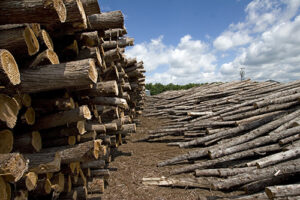 locations in Ashland and Chester, Maine, is to be able to process cedar logs closer to the forest. By de-barking and doing some rough sawing, we can reload more usable logs onto trucks that travel on interstate highways, which have lower weight limits. By removing the excess material from raw logs, we decrease the amount of overall trucking which saves money.
locations in Ashland and Chester, Maine, is to be able to process cedar logs closer to the forest. By de-barking and doing some rough sawing, we can reload more usable logs onto trucks that travel on interstate highways, which have lower weight limits. By removing the excess material from raw logs, we decrease the amount of overall trucking which saves money.
Arrival at Oakfield
Northern White Cedar Logs trucked to the Oakfield mill arrive both in raw states with bark attached or rough sawn. The first stop for raw cedar logs is the holding pile. Logs are selected from these large piles and taken to be debarked and rough sawn. The next step in the trip is further processing to prepare for drying. Because Northern White Cedar starts out with a low moisture content, much of the log drying occurs outside in open air sheds. The rough sawn logs 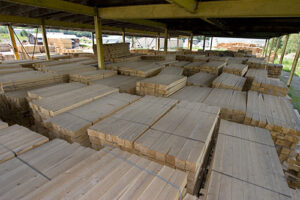 are “stickered” to improve airflow and accelerate the drying process. The ability to air dry cedar provides for a more stable log that is allowed to release inside moisture gradually to achieve equilibrium with the surrounding air. Logs that are marked for log home production will often pass through our kilns to even out moisture levels in humid months.
are “stickered” to improve airflow and accelerate the drying process. The ability to air dry cedar provides for a more stable log that is allowed to release inside moisture gradually to achieve equilibrium with the surrounding air. Logs that are marked for log home production will often pass through our kilns to even out moisture levels in humid months.
Grading Logs
Because logs are grown and harvested in the wild, it’s essential to inspect and grade each log arriving at Katahdin, We use a log grading standard first developed based on the ASTM Standard D3957 to provide standardized grades for structural and no-structural cedar logs used for trim, fencing and other uses.
Finally, the dried, graded and rough sawn logs are transported to the manufacturing house line, where our CAD interface planes, shapes, drills and processes 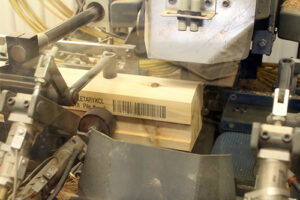 each log to fit perfectly with adjacent logs in your home’s unique design. Each log is also stamped with a bar code to identify its place in the plan, then stacked in a roughly bottom-up building progression that makes construction more time- and cost-efficient. Wrapped and properly labeled, the log completes its journey from the forests of Maine to your Katahdin Cedar Log Home’s building site.
each log to fit perfectly with adjacent logs in your home’s unique design. Each log is also stamped with a bar code to identify its place in the plan, then stacked in a roughly bottom-up building progression that makes construction more time- and cost-efficient. Wrapped and properly labeled, the log completes its journey from the forests of Maine to your Katahdin Cedar Log Home’s building site.
Click here to take a tour of Katahdin Cedar Log Homes’ manufacturing house line.
